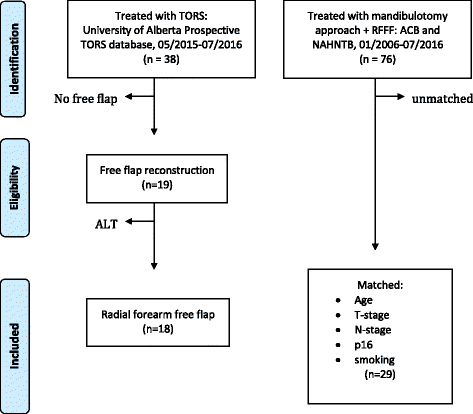Transoral robotic surgery with radial forearm free flap reconstruction: case control analysis
- PMID: 28292318
- PMCID: PMC5351107
- DOI: 10.1186/s40463-017-0196-0
Transoral robotic surgery with radial forearm free flap reconstruction: case control analysis
Abstract
Background: The resection of large oropharyngeal tumors traditionally involves a lip-splitting mandibulotomy for adequate margin visualization and free flap reconstruction of the surgical defect. Transoral robotic surgery (TORS) has emerged as a technique that can resect large and complex oropharyngeal tumors, avoiding a lip-splitting approach. The aim of this study is to compare the lip-splitting mandibulotomy approach versus TORS for the management of advanced stage oropharyngeal carcinomas.
Methods: Prospectively collected data from 18 patients with advanced stage oropharyngeal squamous cell carcinoma (OPSCC) who received TORS with radial forearm free flap reconstruction (RFFF) was compared to a matched cohort of 39 patients who received a lip-splitting mandibulotomy and RFFF. Patients were matched for stage, p16 positivity, smoking, age and gender. Length of hospital stay (LOHS), tracheostomy decanulation time, operative time, surgical margin status, and post-operative complications were compared between groups.
Results: Patients who received TORS with RFFF had a significantly lower mean LOHS, compared to patients who were treated by lip-splitting mandibulotomy and RFFF (14.4 vs 19.7 days, p = 0.03). No significant differences were seen between groups in terms of operative time, tracheostomy decannulation time, margin positivity and post-operative complications.
Conclusion: TORS with radial forearm free flap reconstruction is a safe, effective and cost-saving alternative to the lip-splitting mandibulotomy approach for the treatment of advanced stage OPSCC.
Keywords: Human papillomavirus; Mandibulotomy; Oropharyngeal cancer; Radial forearm free flap; Transoral robotic surgery.
Figures
Similar articles
-
Characteristics and outcomes of transoral robotic surgery with free-flap reconstruction for oropharyngeal cancer: a systematic review.J Robot Surg. 2023 Aug;17(4):1287-1297. doi: 10.1007/s11701-023-01572-4. Epub 2023 Mar 25. J Robot Surg. 2023. PMID: 36964850
-
Retropharyngeal Internal Carotid Artery Management in TORS Using Microvascular Reconstruction.Laryngoscope. 2021 Mar;131(3):E821-E827. doi: 10.1002/lary.28876. Epub 2020 Jul 4. Laryngoscope. 2021. PMID: 32621638
-
Feasibility of Free Flap Reconstruction Following Salvage Robotic-Assisted Resection of Recurrent and Residual Oropharyngeal Cancer in 3 Patients.Ear Nose Throat J. 2021 Dec;100(10_suppl):1113S-1118S. doi: 10.1177/0145561320937627. Epub 2020 Jul 1. Ear Nose Throat J. 2021. PMID: 32608257
-
Primary surgical management with radial forearm free flap reconstruction in T4 oropharyngeal cancer: Complications and functional outcomes.Am J Otolaryngol. 2018 Mar-Apr;39(2):116-121. doi: 10.1016/j.amjoto.2017.12.012. Epub 2017 Dec 18. Am J Otolaryngol. 2018. PMID: 29279248
-
Comparative safety and effectiveness of transoral robotic surgery versus open surgery for oropharyngeal cancer: A systematic review and meta-analysis.Eur J Surg Oncol. 2020 Apr;46(4 Pt A):644-649. doi: 10.1016/j.ejso.2019.09.185. Epub 2019 Sep 25. Eur J Surg Oncol. 2020. PMID: 31627931
Cited by
-
Head and neck cancer: improving outcomes with a multidisciplinary approach.Cancer Manag Res. 2017 Aug 18;9:363-371. doi: 10.2147/CMAR.S115761. eCollection 2017. Cancer Manag Res. 2017. PMID: 28860859 Free PMC article. Review.
-
Does Combined Access Mandibulotomy, Rim Mandibulectomy and Neck Dissection Compound the Late Effects of Radiotherapy?Plast Reconstr Surg Glob Open. 2023 Jun 14;11(6):e5081. doi: 10.1097/GOX.0000000000005081. eCollection 2023 Jun. Plast Reconstr Surg Glob Open. 2023. PMID: 37325373 Free PMC article. No abstract available.
-
A national study of choanal atresia in tertiary care centers in Canada - part I: clinical presentation.J Otolaryngol Head Neck Surg. 2021 Jul 12;50(1):45. doi: 10.1186/s40463-021-00517-x. J Otolaryngol Head Neck Surg. 2021. PMID: 34253250 Free PMC article.
-
Role of TORS as De-Escalation Strategy in HPV-Related Oropharyngeal Cancer, What We Need to Know.Healthcare (Basel). 2024 May 14;12(10):1014. doi: 10.3390/healthcare12101014. Healthcare (Basel). 2024. PMID: 38786424 Free PMC article. Review.
-
Practice patterns in transoral robotic surgery: results of an American head and neck society survey.J Robot Surg. 2023 Apr;17(2):549-556. doi: 10.1007/s11701-022-01448-z. Epub 2022 Aug 7. J Robot Surg. 2023. PMID: 35933632
References
MeSH terms
LinkOut - more resources
Full Text Sources
Other Literature Sources
Medical


